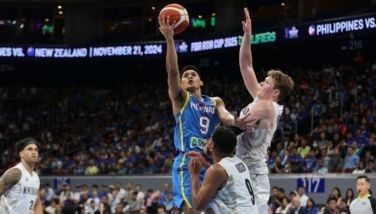The 'blind' side

A few weeks ago, I wrote about people with disabilities. I was also going to write about the visually impaired but I ran out of space. I do not intend to put this issue aside since it is a very important one as well.
The “blind” as we use to call them are now called the “visually impaired”. According to Resources for the Blind, Inc. there are more than half a million blind people and many more who are visually impaired to a lesser degree in the Philippines. Statistics also reveal that about 100 children lose their sight every week.
Almost half of these cases are either treatable or preventable. Poor nutrition, measles, and premature birth are among the leading causes of preventable blindness in children. Early detection and treatment will save their sight. On the other hand, cataract is said to be the major cause of blindness among adults accounting for around 400,000 cases. The treatment of cataract is simple and effective but the problem is, it is not readily available or affordable for the less privilege.
We had a student at OB Montessori Center (OBMC) who is visually impaired. His name is Joshua. He was able to graduate from OBMC high school and is now in college at St. Benilde taking up a degree in Consular and Diplomatic Affairs.
Joshua lost his eyesight due to a congenital corneal anomaly. For some reason, his condition became worse after an operation. His parents took him to America but the doctors there could not do anything anymore.
Joshua is a fortunate child. His parents can afford to send him to a private school, hire the services of a clinical psychologist, an occupational therapist and an aide to supervise his daily work and activities. He is also able to acquire different gadgets for the blind that help him become functional.
After preschool, his mother was worried that OBMC will ask him to look for a school that specializes in educating the blind. After a series of meetings with OBMC officials, they decided to keep Joshua. This was its first endeavor in teaching the visually impaired. The school and the home worked closely together to help Joshua maximize his potential.
The mother persuaded OBMC to accept her son because at that time there were only very few public schools in the Philippines that would accept visually impaired children and no private schools would open their doors to them.
When I asked Joshua’s mom what happens to those children who cannot afford all these, she told me that most of them just stay home. They are kept away from the mainstream of society. What a pity!
More than anything else, blind children also want to be able to go to school. They have normal intelligence and can learn as easily and as quickly as any other child their age. They have hopes and dreams for the future and they know that a good education will help make those dreams come true.
Parents Advocates for Visually Impaired Children (PAVIC) is a non-government organization that is a support group. It is a young organization that began three years ago. The group is resolved to work towards educational access for children with visual impairment and to increase school enrolment. They also want to encourage more parents to bring out their children into the mainstream of society.
Resources for the Blind, Inc. (RBI) is a non-government Christian organization serving blind people all over the Philippines since 1988. It has a staff of 50 blindness specialists in Manila, Davao and Cebu offices. It is a personal project of Dr. Arthur Lown who was blind since childhood. He retired as Director of the Atlanta Public Schools Services for Blind students in 1970 and moved to the Philippines to serve as administrator of the Summer Institute of Liguistics until he started RBI.
RBI produces Braille books and distributes them nationwide. Joshua gets most of his materials from them. The organization also conducts many projects: Bible College for the Blind, Integrated Education, livelihood programs, summer camps, computer training and employment training.
There are about 2,000 blind students around the country who need their textbooks converted to Braille. Approximately 5,000 volumes of textbooks are sent out each year to students. As many as half a million of text pages are converted to electronic view by RBI annually. What happens then to the visually impaired without RBI? Our government seems to have no alternative program or service for the visually impaired. By the way, RBI caters to only a segment of our society. I wonder what happens to those who have no access to RBI.
Visual impairments can mean a number of things. If you are visually impaired it doesn’t necessarily mean you are blind, it could mean you are blind or have impaired vision. A person who is totally blind can not see light or anything else. Some people use different things to help with their visual impairments by using adaptive equipment, computers, optical devices, Braille and guide dogs.
Our society must be proactive in helping the visually impaired. We must make them functional citizens because they have the capacity and ability to be productive. We have just taken them for granted like the rest of our countrymen with disabilities. I wonder why DepEd and the DSWD have not brought sophistication to their programs and facilities? We still have a long way to achieve all these. We also need a friendlier and more compassionate society. We need a stronger voice in Congress. God help us!
* * *
“I don’t want to be on these talk shows, giving my opinion, second guessing the current President. I think it’s bad for the country, frankly, to have a former president criticize his successor.” This was George W. Bush’s statement after Obama became President. Clinton opted to do the same – he avoiding talking about Bush.
For GMA, it’s the other way around. She has gained some force to throw issues about P-Noy. Shouldn’t it be the other way around? Although she has pointed out some vital issues, I think it is still not becoming for her to take such stands – these may just boomerang back to her in the end. Anyway, I would like to believe that her high kicks will challenge P-Noy to move forward.
As for media, why do we take one president and try to fit him or her into the mold of another? Maybe it is because more than halfway through his term, we just cannot agree on who P-Noy really is. I hope and wish that during the SONA, P-Noy will show us what type of President he wants to become. Mr. President, do let us know how you will resolve our country’s problems. You do not have to resort to a counter-attack on your predecessor. Otherwise, you can be misconstrued as “onion-skinned” or worse — too juvenile to lead the country.
- Latest
- Trending
































